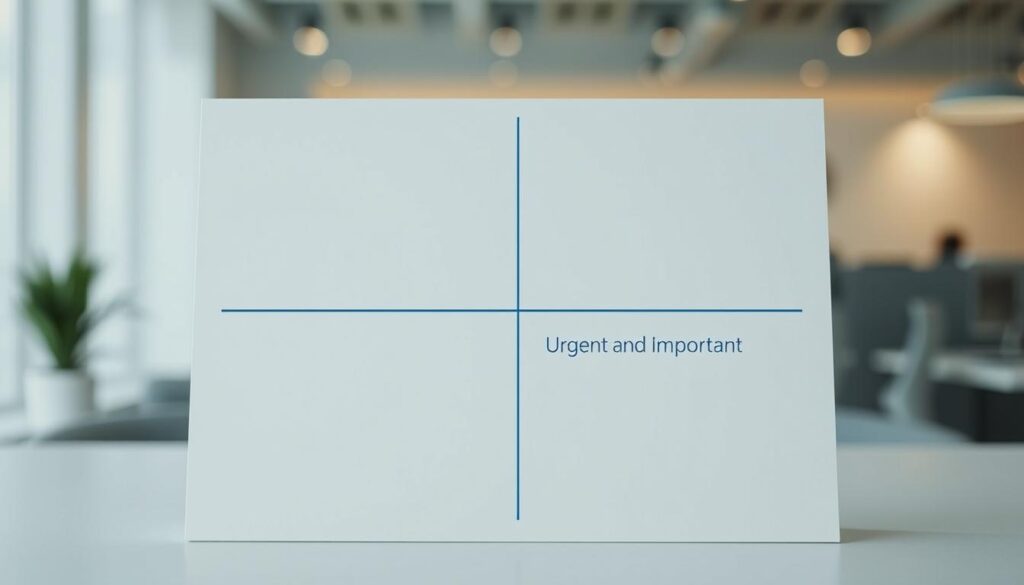Blog
The Eisenhower Matrix Hack: Stop Doing Everything and Focus on What Matters

In today’s fast-paced world, effective prioritization is crucial for achieving success. The Eisenhower Matrix is a simple yet powerful productivity tool that helps individuals prioritize tasks, eliminate distractions, and focus on what really matters.
According to Verywell Mind, the Eisenhower Matrix is a valuable resource for time management and prioritization. By using this matrix, individuals can categorize tasks into four quadrants: urgent and important, important but not urgent, urgent but not important, and not urgent or important.
This decision-making tool enables individuals to streamline their workflow, reduce stress, and increase productivity.
Key Takeaways
- Understand the Eisenhower Matrix and its role in prioritization.
- Learn how to categorize tasks into four quadrants.
- Discover how to eliminate distractions and focus on what’s important.
- Improve productivity by streamlining your workflow.
- Reduce stress by making informed decisions.
Understanding the Eisenhower Decision Matrix
The Eisenhower Decision Matrix is a powerful tool for prioritizing tasks based on their urgency and importance. This matrix was born out of President Dwight Eisenhower’s management style, emphasizing the distinction between urgency and importance.
The Origin Story: President Eisenhower’s Productivity Secret
President Eisenhower’s productivity secret lay in his ability to differentiate between tasks that are urgent, important, both, or neither. As quoted by Stephen Covey, “The key is not to prioritize what’s on your schedule, but to schedule your priorities.” This philosophy is at the heart of the Eisenhower Matrix.
The Four Quadrants Explained
The Eisenhower Matrix categorizes tasks into four quadrants:
| Quadrant | Urgency | Importance | Action |
|---|---|---|---|
| 1 | Urgent | Important | Do First |
| 2 | Not Urgent | Important | Schedule |
| 3 | Urgent | Not Important | Delegate |
| 4 | Not Urgent | Not Important | Eliminate |
Understanding these quadrants is crucial for effective decision making and task management, helping individuals focus on what truly matters by distinguishing between tasks that are urgent vs important.
Why Traditional Time Management Fails
Despite its popularity, traditional time management frequently fails to deliver results due to its lack of focus on task prioritization. Traditional time management often emphasizes completing tasks efficiently, but it overlooks the importance of identifying which tasks are truly critical.
The Productivity Paradox
The productivity paradox refers to the phenomenon where increased efforts and resources do not necessarily lead to proportional increases in productivity. This occurs because traditional time management methods often fail to distinguish between urgent and important tasks, leading to wasted effort on non-essential activities.
The Myth of Multitasking
Multitasking, a common practice in traditional time management, is often counterproductive. Research has shown that multitasking can decrease productivity by up to 40% due to the constant switching between tasks, which can lead to mental fatigue and decreased focus. Focusing on a single task at a time, as facilitated by tools like the Eisenhower Matrix, can significantly enhance productivity and reduce stress.
By understanding the limitations of traditional time management and adopting a more effective productivity tool like the Eisenhower Matrix, individuals can better prioritize their tasks and achieve greater productivity.
The Psychology Behind Prioritization
The way we prioritize tasks is deeply rooted in psychological principles. Effective prioritization isn’t just about managing time; it’s about understanding the psychological factors that influence our decision-making processes.
Decision Fatigue and Task Management
Decision fatigue refers to the mental exhaustion that comes from making numerous decisions. When we’re faced with too many tasks, our ability to make sound decisions deteriorates. The Eisenhower Matrix helps mitigate this by simplifying the decision-making process. By categorizing tasks into four quadrants, we reduce the cognitive load associated with prioritization.
As Stephen Covey once said, “The key is not to prioritize what’s on your schedule, but to schedule your priorities.” This approach helps in managing decision fatigue by focusing on what’s truly important.
The Urgent-Important Distinction
The distinction between urgency and importance is crucial for effective prioritization. Urgent tasks demand immediate attention but aren’t always important. Important tasks, on the other hand, contribute to long-term goals and outcomes. The Eisenhower Matrix emphasizes this distinction, helping individuals focus on tasks that are truly important.
“The distinction between urgency and importance is crucial for effective prioritization,” as noted by Verywell Mind. This insight underscores the value of the Eisenhower Matrix in decision-making.
By understanding the psychological underpinnings of prioritization, we can make more informed decisions about how to allocate our time and energy.
Setting Up Your Personal Eisenhower Matrix
Creating a personalized Eisenhower Matrix allows you to prioritize tasks based on their urgency and importance. This simple yet effective tool can be adapted to various contexts, from personal task management to professional project planning.
Digital vs. Physical Matrix Options
When deciding how to implement your Eisenhower Matrix, you have the option to use either digital tools or physical notebooks. According to Verywell Mind, both methods have their advantages. Digital tools offer accessibility and ease of updating, while physical notebooks provide a tactile experience and can be more engaging for some users.
- Digital Tools: Apps like Todoist, Trello, and Microsoft To Do allow for easy categorization and prioritization of tasks. They also offer features like reminders and notifications.
- Physical Notebooks: Using a notebook or a printed template can be a more personal and creative approach. It allows for flexibility in design and can be less distracting than digital screens.

Step-by-Step Implementation Guide
Creating Your First Matrix
To create your Eisenhower Matrix, start by drawing a large square divided into four quadrants. Label the quadrants as follows:
- Urgent and Important (Do First)
- Not Urgent but Important (Schedule)
- Urgent but Not Important (Delegate)
- Not Urgent and Not Important (Eliminate)
This structure will help you visualize your tasks and prioritize them effectively.
Categorizing Your Tasks
Once your matrix is set up, begin categorizing your tasks into the appropriate quadrants. Ask yourself:
- Is this task urgent, important, both, or neither?
- Does this task have a deadline or significant consequences if not completed on time?
- Can this task be delegated to someone else?
By systematically evaluating your tasks, you can make informed decisions about how to manage your time and increase your productivity.
Quadrant 1: Urgent and Important Tasks
Understanding Quadrant 1 is crucial for effective time management and decision making. Tasks that fall into this quadrant are both urgent and important, requiring immediate attention.
Identifying True Crises and Deadlines
To effectively manage Quadrant 1 tasks, it’s essential to identify true crises and deadlines. This involves evaluating tasks based on their urgency and importance, and distinguishing between tasks that are truly critical and those that can be delegated or eliminated. For more insights on effective task management, you can refer to resources like time management strategies.
Strategies for Handling Quadrant 1 Tasks
Handling Quadrant 1 tasks requires a combination of crisis management and prioritization skills. This includes:
- Assessing the task’s urgency and importance
- Delegating tasks when possible
- Focusing on high-impact tasks
Crisis Management Techniques
Effective crisis management involves staying calm under pressure, assessing situations quickly, and making informed decisions. Techniques include:
- Remaining focused on the task at hand
- Prioritizing tasks based on their impact
- Communicating clearly with team members and stakeholders
Quadrant 2: Important but Not Urgent Tasks
Quadrant 2 of the Eisenhower Matrix is where individuals can cultivate long-term value by focusing on important but not urgent tasks. This quadrant is critical for personal and professional growth, as it encompasses activities that contribute to long-term goals and objectives.
The Growth and Planning Quadrant
Tasks in Quadrant 2 are characterized by their importance to long-term success, but lack the urgency that triggers immediate action. Examples include strategic planning, relationship building, and personal development activities. According to Verywell Mind, Quadrant 2 tasks are essential for long-term growth and planning.
Techniques for Prioritizing Long-Term Value
To effectively prioritize tasks in Quadrant 2, individuals can use several techniques. First, they should identify tasks that align with their long-term goals and values. Scheduling regular time blocks for these activities is crucial, as it ensures that important tasks are not neglected due to urgent ones.
Scheduling Deep Work Sessions
One effective technique for prioritizing Quadrant 2 tasks is scheduling deep work sessions. This involves dedicating uninterrupted time to focus on important tasks, thereby increasing productivity and reducing the likelihood of task creep. By minimizing distractions during these sessions, individuals can make significant progress on their long-term objectives.
By prioritizing Quadrant 2 tasks and utilizing techniques like deep work sessions, individuals can enhance their productivity and make meaningful progress toward their goals.
Quadrant 3: Urgent but Not Bour Important Tasks
Dealing with tasks that are urgent but not important requires a strategic approach to minimize distractions. These tasks, while demanding immediate attention, often divert our focus from more critical objectives.
Recognizing Distractions and Interruptions
Identifying tasks that are urgent but not important is the first step in managing them effectively. Common examples include non-essential emails, interruptions from colleagues, and unnecessary meetings.
Delegation Strategies and Techniques
Once identified, many of these tasks can be delegated to others. Effective delegation involves clearly communicating the task requirements and deadlines. It’s also crucial to empower team members by providing the necessary resources and authority to complete the tasks.
Setting Boundaries with Colleagues and Family
Setting clear boundaries is essential to minimize interruptions. This can involve communicating your work hours and focus times to colleagues and family members. By doing so, you can significantly reduce the number of urgent but not important tasks you need to handle.
By implementing these strategies, you can improve your time management and decision making skills, allowing you to focus on tasks that are truly important.
Quadrant 4: Neither Urgent Nor Important Tasks
Tasks that fall into Quadrant 4 of the Eisenhower Matrix are often considered time wasters. These tasks are neither urgent nor important, and they can significantly drain productivity if not managed properly.
As a productivity tool, the Eisenhower Matrix helps individuals identify and eliminate such non-essential tasks, thereby enhancing their ability to focus on what truly matters.
Eliminating Time Wasters
To effectively manage Quadrant 4 tasks, it’s crucial to identify them first. Common examples include excessive social media browsing, watching too much TV, or engaging in other leisure activities that are not aligned with personal or professional goals.
| Task | Time Spent | Potential Replacement |
|---|---|---|
| Social Media Browsing | 2 hours/day | Learning a new skill |
| Watching TV | 3 hours/day | Exercise or reading |
| Playing Video Games | 1 hour/day | Planning or organizing tasks |
When Recreation Becomes Procrastination
It’s essential to differentiate between recreation and procrastination. While some leisure activities are necessary for relaxation, excessive engagement can lead to procrastination. Effective prioritization involves setting boundaries and allocating time wisely.
By minimizing time spent on Quadrant 4 tasks, individuals can redirect their energy towards more productive and fulfilling activities.

Advanced Time Management Using the Eisenhower Principle
The Eisenhower Matrix can be a powerful tool when used in conjunction with other productivity systems. By integrating it with various time management techniques, individuals can significantly enhance their productivity and task management capabilities.
Weekly Planning Sessions
One effective way to utilize the Eisenhower Matrix is by incorporating weekly planning sessions into your routine. During these sessions, review your tasks and categorize them using the Matrix. This helps in prioritizing tasks and allocating time efficiently. Consistency is key to making this practice effective.
Integrating with Other Productivity Systems
The Eisenhower Matrix can be seamlessly integrated with other productivity systems to boost its effectiveness. Two popular methods for integration are the Pomodoro Technique and Getting Things Done (GTD).
Combining with Pomodoro Technique
The Pomodoro Technique involves working in focused 25-minute increments, followed by a 5-minute break. By combining this technique with the Eisenhower Matrix, you can enhance your focus on critical tasks. For instance, dedicate your Pomodoro sessions to tasks classified as Urgent and Important (Quadrant 1).
Using with Getting Things Done (GTD)
Getting Things Done is a task management system that emphasizes capturing all tasks and projects. When combined with the Eisenhower Matrix, GTD can help in organizing tasks into the four quadrants, making it easier to prioritize and manage them. This integration allows for a more comprehensive approach to task management.
By adopting these advanced time management strategies, individuals can optimize their productivity and achieve a better work-life balance. The key is to remain flexible and adapt these techniques to suit your specific needs.
Adapting the Matrix for Different Contexts
Adapting the Eisenhower Matrix to different contexts can significantly enhance its effectiveness. The matrix’s versatility allows it to be applied to various aspects of life, from professional projects to personal tasks.
Eisenhower Matrix for Work Projects
In a work setting, the Eisenhower Matrix can be used to prioritize tasks based on their urgency and importance. This helps teams focus on critical projects and manage deadlines more efficiently. For instance, tasks that are both urgent and important (Quadrant 1) should be addressed immediately, while important but non-urgent tasks (Quadrant 2) are scheduled for later.
Using the Matrix for Personal Life and Family
The Eisenhower Matrix is not limited to professional use; it can also be applied to personal life and family commitments. By categorizing personal tasks into the four quadrants, individuals can better manage their time and reduce stress. For example, planning a family vacation (Quadrant 2) can be scheduled in advance, while dealing with a household emergency (Quadrant 1) requires immediate attention.
Customizing for Different Personality Types
Different personality types may benefit from customizing the Eisenhower Matrix to suit their preferences. For instance, visual learners might prefer a graphical representation, while detail-oriented individuals might focus on categorizing tasks into detailed sub-tasks.
By adapting the matrix to individual needs, users can enhance their decision-making capabilities and improve overall productivity.
Common Pitfalls and How to Overcome Them
To maximize the benefits of the Eisenhower Matrix, it’s crucial to be aware of the potential pitfalls that can affect its implementation. While this powerful time management tool can significantly enhance productivity, users often encounter challenges that can limit its effectiveness.
Misclassifying Tasks
One of the most common pitfalls is misclassifying tasks into the wrong quadrant. This can lead to important tasks being neglected or trivial tasks consuming too much time. To avoid this, it’s essential to regularly review and adjust task classifications.
- Be honest about task urgency and importance.
- Consider the long-term implications of tasks.
- Use a consistent decision-making process for task classification.
Matrix Abandonment: Why People Quit
Another challenge is abandoning the Eisenhower Matrix altogether. This often happens due to initial unrealistic expectations or frustration with the time it takes to see results. To overcome this, it’s crucial to understand that the matrix is a tool that requires consistent use and adaptation.
Overcoming Resistance to Change
Implementing the Eisenhower Matrix may require significant changes in how tasks are managed and prioritized. Resistance to this change can be a major obstacle. Strategies to overcome this include gradual implementation, training, and highlighting the benefits of the matrix in improving productivity.
- Start with small, manageable changes.
- Provide training and support.
- Monitor progress and adjust as necessary.
By being aware of these common pitfalls and implementing strategies to overcome them, users can maximize the benefits of the Eisenhower Matrix as a productivity tool, leading to more effective time management.
Conclusion: From Overwhelm to Focused Productivity
By applying the Eisenhower Matrix, individuals can transform their task management approach, shifting from feeling overwhelmed to achieving focused productivity. This simple yet powerful tool enables effective prioritization by distinguishing between tasks that are urgent vs important.
The matrix helps individuals categorize tasks into four quadrants, allowing them to concentrate on what truly matters. By doing so, they can eliminate non-essential tasks, reduce stress, and increase productivity. Effective prioritization is key to achieving this balance.
As demonstrated throughout this article, the Eisenhower Matrix is a versatile tool that can be adapted to various contexts, including work projects and personal life. By integrating this matrix into daily planning, individuals can make significant strides in achieving their goals.
By mastering the art of prioritization using the Eisenhower Matrix, individuals can experience a profound impact on their productivity and overall well-being. It’s time to put this powerful tool into practice and start achieving focused productivity.








